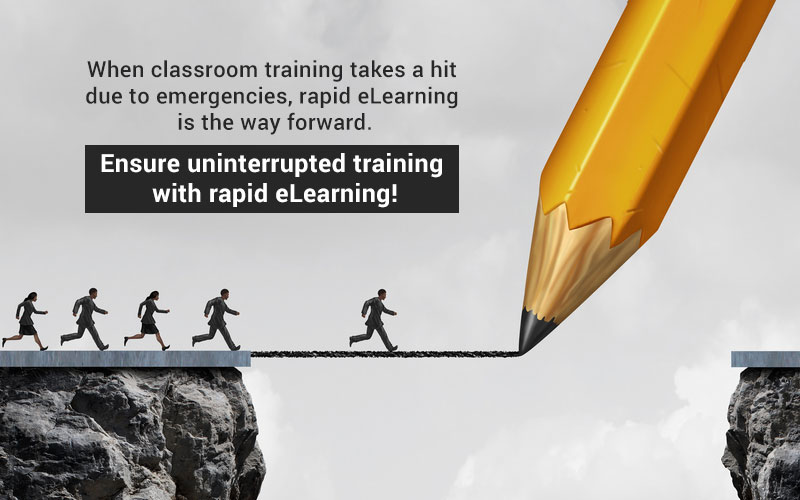4 Tips to Implement Rapid E-learning in Times Like Corona

It’s time for rapid eLearning to be taken seriously by the corporate world. Why?
Let’s admit that corporate training in the time of Corona is DIFFICULT.
COVID-19 has disrupted all aspects of the corporate landscape, and one of the most disrupted is training.
Organizations that have held on to classroom-based training for their employees are the ones most affected by emergencies such as the one we are in the midst of.
Employee travel for training is not on – at least for the foreseeable future!
So, what’s the solution?
Moving your training online to ensure the business workflow continues, and training disruptions are overcome – even with employees working from home. And one of the quickest ways to do this is through rapid eLearning.
In this blog, we will look at 4 tips on how to get around training disruptions by leveraging existing classroom and other material for online training – within budget and timelines – with rapid eLearning.
How to Get Rapid E-learning Right?
- Collate existing training material for the ‘rapid’ conversion
- Pick a rapid authoring tool that does the job on a budget
- Decide the delivery output/s for online instruction
- Outsource the conversion job to a rapid eLearning expert
Rapid eLearning for Solving Training Disruptions: 4 Recommendations
1. Collate Existing Training Material for the ‘Rapid’ Conversion
Classroom training material is available in different formats – PPTs, participant handouts, lecture recordings (audio/video), graphic organizers such as graphs and diagrams, paper-based material such as textbooks and workbooks, etc. You also have a lot of other material – brochures, PDFs, promotional material that can be used as source material for rapid eLearning.
Not all of this is suitable for online learning – at least not in its original form.
There’s a huge misconception about rapid eLearning – that you simply dump all the content into a conversion tool (ta da!) to get your online course.
Not really! However good the source material is, it still needs some work to make it ready for online. For instance:
PPTs usually have very sketchy notes that are merely intended to guide the instructor on important points. The instructor draws on his vast knowledge and experience to explain each slide, adding anecdotes and real-life scenarios where needed.
And the instructor is the one who keeps his learners engaged through activities and Q&A sessions.
Online training has to factor in for absence of the instructor – taking care of the explanation and adding interactivities and audio narration to make the courses engaging. In short, the course has to be instructionally ‘designed’!
Assessing learners’ understanding in the classroom involves the instructor asking questions and receiving answers from the learners.
Online learning courses, on the hand, need to have practice questions after each topic/module (formative assessments) and a final quiz (summative assessment) at the end of the course.
Rapid eLearning is based on sound instructional design principles and strategies, ensuring the content is tailored for an online audience.
A Pro Tip: Before you begin the conversion, collate all ILT material and sort/divide it in terms of type (paper-based, PPTs, or even old courses) and media formats (audio, video, images). Doing so will make the designer’s job SUPER EASY (ok, it’s still not that easy) and also SPEED-UP the development process.
Download our eGuide on the Best Practices for Rapid eLearning Design
2. Pick a Rapid Authoring Tool that does the Job on a Budget
Rapid eLearning development is only possible thanks to rapid authoring tools. A number of authoring tools are available, capable of producing online courses rapidly, such as Articulate 360, Adobe Captivate, Lectora Inspire, iSpring, among others.
These authoring tools come with a lot of built-in assets – a library of pre-built templates, a suite of interactivities, assessment templates, online review options, among others, which are very useful in cutting down the overall development time.
Built-in Templates: With templates, developers don’t have to create courses from scratch. As templates provide the framework for designing courses, content can be rapidly integrated and published, achieving scalability like never before.
As development progresses, common screens and components can be identified and standardized for reuse – speeding up the development process.
A Pro Tip: Standardize templates for learning objectives, interactivities, assessments, results, summary, survey, and acknowledgment screens, which are similar for all courses. This will greatly quicken the conversion process.
Libraries: Having access to the tool’s libraries – which include a wide variety of layouts, inbuilt games, and interactive scenarios – means interactive scenario- and game-based learning can be created quickly and easily, improving the quality of eLearning courses.
Online Review Options: The tool’s online review options make it easy for the developer and the reviewers (usually SMEs who usually are very busy people) to communicate and validate courses. This is an important aspect of rapid development, as too much back-and-forth can eat away the development time otherwise.
In addition to this, rapid authoring tools offer support for creating responsive eLearning – where developers don’t have to create separate courses for separate devices. Rather, a single master course is developed and published, which can be accessed on any device regardless of the screen size and dimension/s.
3. Decide the Delivery Output/s for the Online Instruction
Employees have different learning styles and preferences. How can you ensure each learner’s needs and preferences are taken care of – all without spending TOO MUCH TIME AND MONEY?
Simple, use different eLearning formats!
Here are some of the digital learning formats to deliver eLearning:
- Microlearning modules
- Videos
- Game-based modules
- Simulation-based learning
- VR walkthroughs
Thanks to the latest authoring tools, these digital formats can be rapidly developed more easily and quickly than standalone eLearning courses. As I mentioned earlier, templates are already available for creating these formats and, hence, not everything needs to be done from the scratch.
Moreover, whenever content changes/updates are needed, they can be made easily to the relevant module – saving valuable development time and money.
Note: The courses offered in these formats are accessible on laptops, desktops, or on mobile devices via a portal or an online repository.
Speaking of the delivery mechanism, you can strengthen your online learning program by investing in an LMS if you haven’t already. An LMS is a centralized repository for all your training material that can host and disseminate the courses to the employees no matter where they are.
Below is an infographic on what an LMS is and what its benefits are for corporate training.
4. Outsource the Conversion Job to a Rapid E-learning Expert
Does your organization have an internal eLearning development team? Do they have the skills to use the rapid authoring tools and develop courses rapidly?
Successful rapid eLearning development relies not just on rapid authoring tools but also on the expertise of those wielding the tools and, not to forget, on robust project management.
Outsourcing your development process to an eLearning expert brings many advantages to an organization.
A rapid eLearning vendor has a pool of experts in instructional design and authoring tools to scale up or scale down the eLearning development and deliver courses within stipulated timelines.
They will have also have a robust and agile project management process in place to achieve a quick and cost-effective training rollout.
Concluding Remarks
A disruption in training is never good, both for the employee and the business. Classroom training can never be replaced entirely (and may hold a special place in the heart of learning professionals), but it definitely falls short during emergencies like the one we are facing today. Therefore, move training online where employees can learn from the comfort of their homes.
Outsourcing your rapid eLearning development project can be a quite confusing if you are doing it for the first time. Access our practical guide on outsourcing and learn how to pick a good vendor & how to support them for a successful outsourcing journey.


![Learning Management System: Definition and Advantages [Infographic] Learning Management System: Definition and Advantages [Infographic]](https://blog.commlabindia.com/hs-fs/hubfs/Imported_Blog_Media/lms-definition-and-advantages-infographic.png?width=750&height=2104&name=lms-definition-and-advantages-infographic.png)



